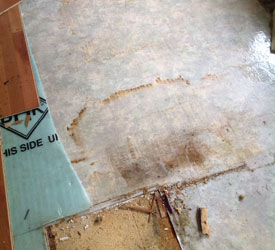Just how to avoid a Water Damaged Bathroom
Just how to avoid a Water Damaged Bathroom
Blog Article
This great article listed below relating to Looking for Signs of Water Damage in the Bathroom is pretty much interesting. Read it for yourself and see what you think of it.

The restroom is very vulnerable for damp buildup and potential water damages as a result of the frequent use of water in it. This write-up offers easy assessment strategies to help finding water damages hazards.
The regular use water in the washroom makes it exceptionally at risk for wet accumulation as well as prospective water damages. By checking it frequently, you can decrease water related problems.
The adhering to set of inspections is very easy to do as well as should be done as soon as in every 3 months in order to keep your bathroom healthy as well as to avoid prospective water damages caused by the bathtub, the shower, pipe joints and plumbing, sinks, cabinets, and also the commode
Do not forget doing these evaluations and also be detailed while executing them. Remember that these basic assessments can save you a lot of money by giving very early signs for water damage
Sinks as well as Cabinets
Sinks and cabinets are subjected to wetness and moisture everyday and are usually ignored. Inspect consistently under the sink as well as on the countertop over it. Repair any drip in the catch as it may recommend drainpipe problems. Check out the sink, sluggish draining pipes might indicate an obstructed drain. Change sink seals if they are split or loose.
Bath tub and Shower
The shower and also tub call for unique attention as well as maintenance. Examine the tiles and also replace if fractured. Ensure that there is no missing out on grout in between the ceramic tiles. Inspect as well as replace split caulking at joints where the walls satisfy the flooring or the tub. Obstructed drains and also pipes troubles will stop the bathtub from drying out and might show major troubles below the bath tub. Speak with a specialist immediately to prevent architectural damages. Take note of stainings or soft areas around the tub wall surfaces as they may suggest an inner leak.
Plumbing
Signs for water damages are tough to spot given that most pipes are mounted inside the walls.
Pay special focus to floor covering and wall surfaces dampness and spots as they might show an unnoticeable plumbing trouble. Check moisture levels in adjacent areas as well.
The Bathroom
The commode is a vulnerable water junction. Inspect the water lines and also search for leaks around the bathroom seat, in the pipe, and also under the water tank. If you spot any type of indicators of moisture on the floor around the bathroom, check for leakages in the toilet edge and also tank seals.
Understand that hanging commode bowl antiperspirants raises the opportunities for clogs.
TIPS TO PREVENT WATER DAMAGE IN THE BATHROOM
The average household uses approximately 80-100 gallons of water per person per day. For a family of 4, that's almost 2,500 gallons of water a week! The largest portion of this consumption comes from bathroom use. Flushing the toilet uses the most water, followed by taking a shower or bath. With that much water running through the home, water damage in the bathroom is bound to happen. Knowing how to spot signs of a water leak is essential to preventing long-term damage. This guide provides you with tips to reduce the impact of water damage on your bathroom.
CAUSES OF BATHROOM WATER DAMAGE
Pipe breaks are the most common cause of water damage we see in our daily jobs. The age of a pipe plays a large role in a pipe break as well as corrosion. Over time, the metal begins to break down, allowing water to escape. Frozen pipe breaks are also a concern in the winter months. Toilet overflows caused by paper products or children flushing inappropriate items. Degraded caulking around the toilet or bathtub can allow water seepage, sometimes behind the fixture, into the subfloor or walls. Condensation forms when the water in a pipe is cooler than the air temperature. Beads of water form on the exterior of the pipes, sometimes so much so that the water begins to drip and pool below. Sink or shower backups created by poor drainage. HOW TO PREVENT WATER DAMAGE IN YOUR BATHROOM
Inspect your toilet supply line for worn or frayed hoses and replace them as needed. Winterize your plumbing to prevent a frozen pipe break. Use vent fans to prevent condensation that can lead to mold growth. Routinely check and replace degraded caulking around your toilet or bathtub. Increase the temperature in your toilet tank and insulate your pipes during the warm summer months to keep condensation from forming. Use child safety locks on the toilets. Flush only toilet paper. "Flushable" wet wipes are actually not good for your plumbing system. Additionally, feminine hygiene products should not be flushed. Prevent water from escaping the tub or shower. Make sure shower curtains are in good condition. Inspect shower doors and replace the seal strip if necessary. Wipe up any water that accumulates on the floor and use bath mats. Water left to sit can cause damage to the tiles and flooring. Refrain from using bath products containing heavy oils to avoid a clogged drain.

As a fervent person who reads on How to Repair and Prevent Bathroom Water Damage, I imagined sharing that piece of content was beneficial. Sharing is nice. You never know, you will be doing someone a favor. Thanks so much for going through it.
Visit Website Report this page